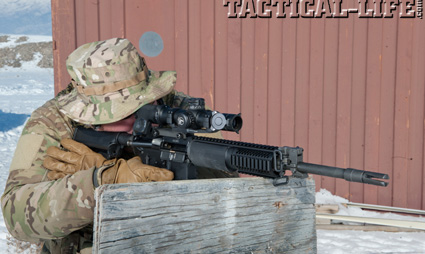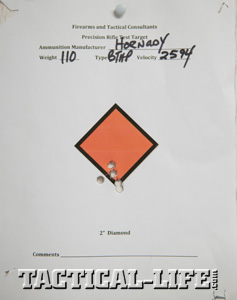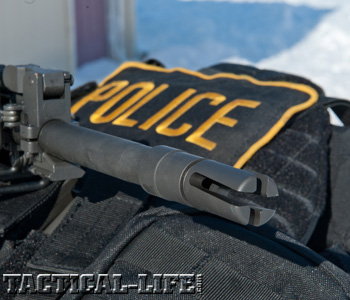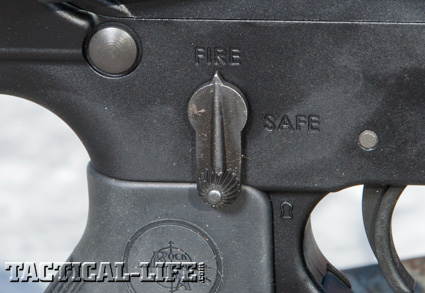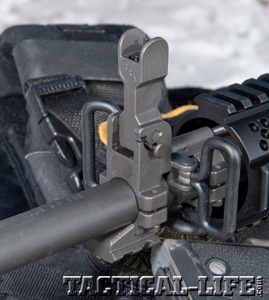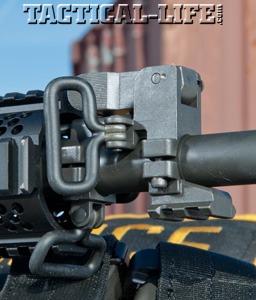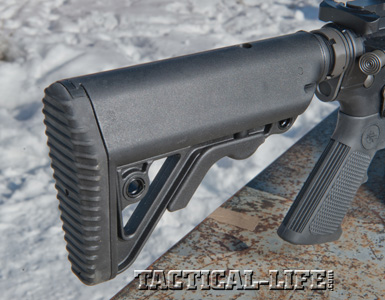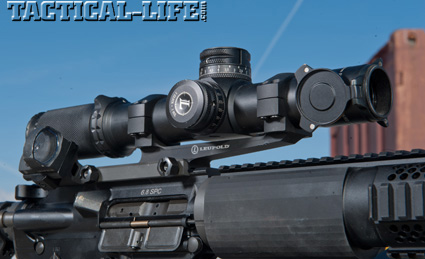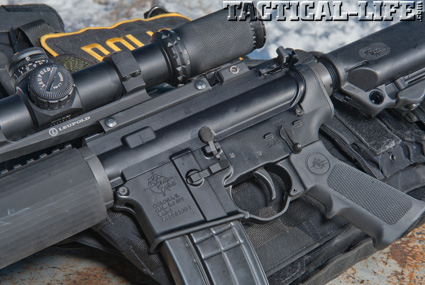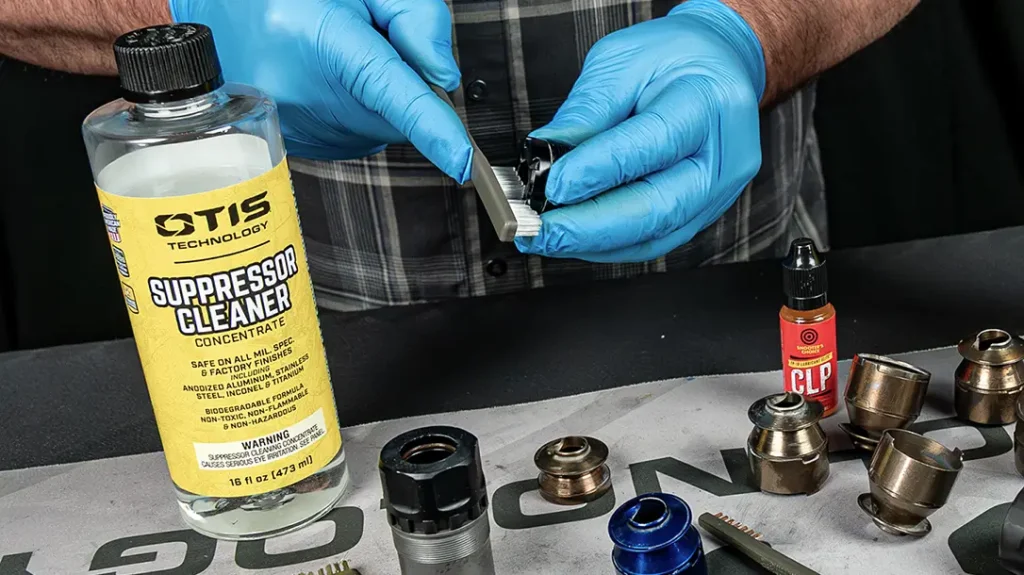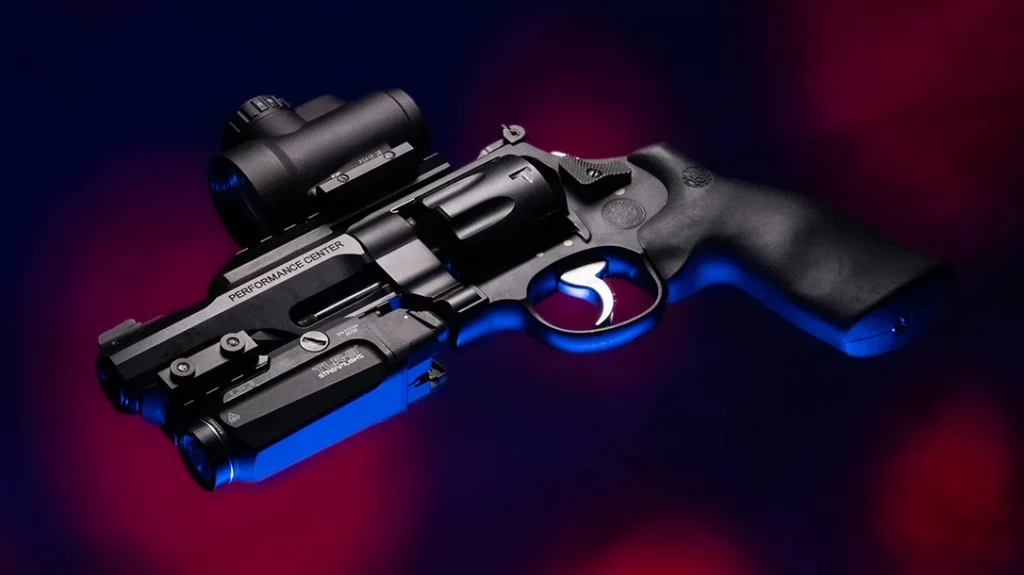Firearms are not immune to the effects of the American consumer’s attention span (or lack thereof)—what was popular last month is old news this month. By the time you get just what you want in a gun or part, it has been discontinued or “improved.” This has, on the one hand, driven innovation on a scale that had been seldom seen in the firearms industry. I’ve been around long enough to remember when choices were few and can say that these developments have been fantastic for the professional operator. However, there is a corresponding dark side. As time, attention and the media machine focus on the latest trend, the tried and true are often abandoned. Two examples are the 6.8 SPC cartridge and rifle.
Steadfast 6.8 SPC
Some recent cartridges like the 300 Blackout (which is certainly proving to be fantastic) have been gaining popularity in the tactical market. For typical urban environments where 200 yards is long range, the 300 BLK is great, but it is no 6.8 SPC. The 6.8 SPC offers tremendous versatility. Loaded with bullets from a 75-grain AP at 3,100 fps to a 115-grain OTM at 2,600 fps, this round can meet just about any mission requirement. Silver State Armory (SSA) offers almost 20 different loads and even makes a 140-grain VLD Berger for those who want long-range accuracy. Given this versatility, the 6.8 SPC remains a viable cartridge at 500 yards with proven stopping power at entry distances. It is still in use by our most elite forces and has been employed with great effect for several years.
I was never a real fan of the 5.56mm NATO, so my search for a larger round was near constant. The 6.8 SPC was brought to my attention while I was still running a SWAT team—it became my round of choice. Even early permutations of the round, which has its limitations, were an improvement over the 5.56mm. And as time went on and Silver State Armory came to the market, the cartridge surpassed the 5.56mm entirely. When the hunting market started to adopt the cartridge, the 6.8 SPC grew exponentially. Handloading opportunities for the 6.8 SPC are fantastic and constantly improving—the round continues to possess a versatility that many other rounds cannot match.
Advertisement — Continue Reading Below
True, the 6.8 SPC requires proprietary magazines, and the choices are slim. The best duty magazine in my experience comes from Barrett, which has supported the caliber tremendously since the beginning, with a truly operational focus. But as good as Barrett magazines are, they do not accept longer bullets. In such cases, Precision Reflex (PRI) magazines are an outstanding option. There are a few more brands out there, but the foregoing has served reliably in all duty conditions. Polymer 6.8 SPC magazines don’t exist at this point, and probably never will while the caliber continues to use the standard 5.56mm magazine well.
The 6.8 SPC also uses a different bolt, which requires a bit more work when attempting to make a conversion. Thankfully, companies have been making 6.8 SPC rifles in every conceivable configuration for years. Like all things AR, these firearms come as short-barreled rifles, piston guns and standard gas impingement rifles. Short barrels seem to work best in piston configurations, especially when suppressed. I’ve tested several 6.8 SPC rifles over the years, and the gas impingement guns tend to be the most accurate over a broad range of ammunition. It can take some effort to make them work with super-light bullets, but it’s worth it for the accuracy. Some of the piston guns I tested shot one type of ammunition into a nice little group and a different type into a shotgun pattern. So for most operators, a good 6.8 SPC gas impingement gun is the way to go.
Carbine Details
It was perfect timing when the opportunity to test a Rock River Arms rifle in 6.8 SPC came up; I was in the market for such a gas impingement AR, and RRA is excellent. RRA’s rifles have always been accurate and reliable, and the company builds them one at a time to your specifications. Many of RRA’s accessories are excellent and well-suited for professional use. I have toured the company’s facility, and it is comprised of real shooters who take their job seriously. RRA’s quality control has been great and its service excellent. And since I intended to keep this rifle, the test gun was built to my specifications.
Advertisement — Continue Reading Below
The build starts with an RRA LAR-6.8 CAR A4 rifle with a Tactical CAR stock and a chrome-moly, 16-inch barrel with a 1-in-10-inch twist rate and a Smith Vortex flash suppressor (chrome-lining of the barrel is available). RRA’s Advanced Half Quad free-floated handguard—one of my favorite designs—covers the barrel. A smooth portion of the handguard, close to the receiver, allows for comfortable handholds, especially in unsupported positions. Short quad-rails up front allow for a light and even a bipod. The long top rail accommodates night vision or lasers. I also had RRA’s flip-up front sight added, which offers a clear sight picture with optics; serves as a solid, dependable back-up iron sight; and adds a small rail perfectly suited for light attachment and sling swivels on both sides and the bottom.
The Tactical CAR was replaced with an Operator CAR stock, which features a better cheekweld, a battery compartment that’s accessible with the push of a button, two QD sling mounts on either side, and six positions for a solid fit. Along with a winter triggerguard, RRA’s overmolded pistol grip was attached. This pistol grip keeps the feel of an A2 grip but with a softer rubber cover. The forged A2 receiver contains RRA’s excellent two-stage trigger. I had installed an ambidextrous safety and magazine release for fast magazine swaps. A BCMGunfighter Charging Handle from Bravo Company with a medium latch rounds out the package. The rifle is sent in a nice hard case along with one PRI (Precision Reflex) 25-round magazine.
For testing purposes I attached a Leupold Mark 8 1.1-8x24mm CQBSS M5B1 scope using the Leupold Mark 8 IMS 34mm mounting system. The Mark 8 scope provides a true 1.1x low range with a crystal clear 8x at the top. A TMR reticle is located in the first focal plane and is illuminated. The 24mm objective keeps things slim, making it perfect for the AR platform. A large knurled ocular lens provides for fast power-adjustment under any condition. Pinch-and-turn knobs graduated in mils make for solid adjustments. To round out the sighting system I mounted a Leupold DeltaPoint reflex sight on the 1 o’clock rail. This micro-dot allows for fast CQB work with a triangle that allows for precision beyond a simple dot.
Advertisement — Continue Reading Below
Range Time
RRA guarantees 1-MOA accuracy, and this rifle delivered. Groups were fired from a seated position using a bag as a rest. The best group came from the Hornady 110-grain BTHP Match at 0.82 inches. SSA’s 115-grain OTM TL came in very close at 0.85 inches, requiring a set of calipers to measure the difference. The largest group was just outside an inch, so the rifle did pretty much all it was supposed to do. It was fed a substantial diet of SSA 110-grain Pro Hunter that proved very accurate and reliable. Firing from kneeling and other unsupported positions at 50 yards, the gun cut an ever-growing hole in the target.
Out to longer ranges, the SSA 115-grain OTM really shines. Originally developed for the military, this round is good at longer ranges. Although temperatures clocked in at a brisk 10 degrees, the skies were clear with no wind. My Tubb Tactical Stake Target was set up for some long-range work. Firing the SSA 115-grain OTM, the RRA was a tack driver at 300 yards. Ten rounds were placed easily in the 7-inch upper portion of the target. With the DeltaPoint and held a bit high on the target, the rifle never missed—the two-stage trigger was a real plus for accuracy.
Moving out to 500 yards, the Mark 8 came into its own. The glass was crystal clear, and the reticle provided for excellent aiming. Coupled with the crisp trigger, the rifle consistently nailed steel using a 3-mil hold. SSA’s tactical load measured 2,610 fps that day. MD ballistics software was used to calculate the holdover, and while it wasn’t quite as precise as my ATrag, it was on my cell phone and quite convenient.
The final bit of testing consisted of shooting in full kit on the move. The stock accommodated my plate carrier without issue. I removed the optics and mounted a simple Aimpoint PRO, which is much better (and lighter) for work up close. While moving on the square range, the RRA balanced well, never malfunctioned and was fast to the target. Some prefer lighter weight handguards, but given my build this is not an issue—fatigue was never an issue throughout the range day. The Smith Enterprises Vortex remains one of my favorite flash suppressors, and it worked well, requiring no timing and knocking down flash as well as any other. Using my Threat 4 communication gear/ear protection, the rifle was plenty comfortable indoors. The LAR 6.8 was also handy while moving in and around buildings and the vehicle. The Barrett magazines had no feeding issues.
Advertisement — Continue Reading Below
Final Notes
RRA builds great rifles, and the LAR-6.8 CAR A4 is no exception. Granted, it was built to my specifications so displeasure was unlikely, but it performed perfectly. The rifle was accurate and functioned reliably with all but the 85-grain ammunition. (The gun actually cycled this without issue but would not hold the bolt open consistently on the last round, which is common with the 6.8 SPC rifles I’ve tested over the years. Many will need a spring change to reliably cycle bullets at 85 grains or less.)
All in all, the LAR-6.8 CAR A4 performed excellently and will be a solid addition to my AR stable. The 6.8 SPC remains an excellent choice for many professionals, and the RRA LAR 6.8 will meet just about any operator’s need. For more information, visit rockriverarms.com or call 866-980-7625.
